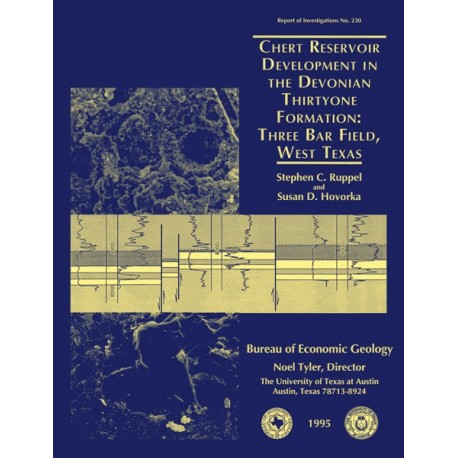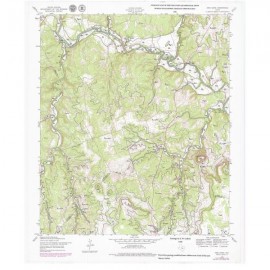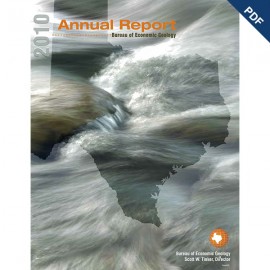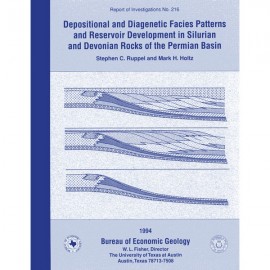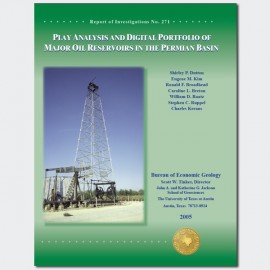Reports of Investigations
-
Books & Reports
- Reports of Investigations
- Guidebooks
- Udden Series
- Geological Circulars
- Down To Earth
- Atlases of Major Oil and Gas Reservoirs
- Texas Memorial Museum Publications
- Environmental Geologic Atlas of the Texas Coastal Zone
- Mineral Resource Circulars
- Other Reports
- Seminars and Workshops
- Handbooks
- Submerged Lands of Texas
- Symposia
- Annual Reports
- Open File Reports
-
Maps & Cross Sections
- Thematic Maps
- Miscellaneous Maps, Charts & Sections
- Geologic Atlas of Texas
- STATEMAP Project Maps
- Geologic Quadrangle Maps
- Cross Sections
- Highway Geology Map
- Energy and Mineral Resource Maps
- Shoreline Change and Other Posters
- Wilcox Group, East Texas, Geological / Hydrological Folios
- Bouguer Gravity Atlas of Texas
- River Basin Regional Studies
- Featured Maps
- Posters
- Teachers & the Public
-
Geological Society Publications
- Gulf Coast Association of Geological Societies
- Alabama Geological Society
- Austin Geological Society
- Corpus Christi Geological Society
- Houston Geological Society
- Lafayette Geological Society
- Mississippi Geological Society
- New Orleans Geological Society
- South Texas Geological Society
- GCS SEPM Publications
- Historic BEG & UT Series
Chert Reservoir Development in the Devonian Thirtyone Formation: Three Bar Field, West Texas
RI0230
For a downloadable, digital version: RI0230D.
RI0230. Chert Reservoir Development in the Devonian Thirtyone Formation: Three Bar Field, West Texas, by S. C. Ruppel and S. D. Hovorka. 50 p., 40 figs., 3 tables, 1995. Print.
To purchase this publication as a downloadable PDF, please order RI0230D.
ABSTRACT
Chert reservoirs of the Lower Devonian Thirtyone Formation represent a substantial part of the hydrocarbon resource in the Permian Basin. More than 700 million barrels of oil has been produced from these rocks, and an equivalent amount of mobile oil remains. Effective exploitation of this sizable remaining resource, however, demands a comprehensive understanding of the complex factors that have contributed to reservoir development.
Analysis of Thirtyone Formation chert deposits in Three Bar field and elsewhere in the Permian Basin reveals that reservoirs display substantial heterogeneity that results from an interplay of depositional, diagenetic, and structural processes. Large-scale reservoir geometries and finer scale, intrareservoir heterogeneity are attributable primarily to original depositional processes. These cherts, which were deposited by relatively deep water sediment gravity processes along a north-trending depocenter, exhibit relatively continuous stratal geometries, especially in the area of Three Bar field, which contains one of the largest of these reservoirs. Porosity development in these rocks is due principally to variations in rates and end products of early silica diagenesis. Because this diagenesis was partly a function of depositional facies architecture, porosity development follows original depositional patterns.
In reservoirs such as Three Bar field, where the Thirtyone Formation has been unroofed by Pennsylvanian deformation, meteoric diagenesis has added heterogeneity by causing dissolution of chert and carbonate, especially in areas of higher density fracturing and faulting and along truncated reservoir margins. Structural deformation has also controlled heterogeneity directly, particularly in reservoirs under waterflood. High-density fracture zones create preferred flow paths that result in nonuniform sweep through the reservoir. Faulting locally creates fault compartments by offsetting reservoir flow units.
Three Bar field exhibits many of the major styles of heterogeneity that contribute to inefficient recovery in the Thirtyone Formation. As such, the processes and models defined here help explain causes of heterogeneity in all Thirtyone chert reservoirs in the Permian Basin and facilitate recovery of the sizable hydrocarbon resource remaining in these rocks.
Keywords: chert, Devonian, hydrocarbons, Permian Basin, reservoir characterization, silica diagenesis, Thirtyone Formation
CONTENTS
Abstract
Introduction
Previous Work
Methods
Regional Setting
General Stratigraphy and Facies
Regional Trends in Thirtyone Formation Reservoir Development
General Setting of Three Bar Field
Stratigraphy and Facies
Introduction
Thirtyone Formation Facies
Translucent Nonporous Chert
Porcelaneous Porous Chert
Carbonate
Facies Architecture
Paleoenvironments and Depositional History
Structural Setting
Brecciation and Fracturing
Styles
Causes and Timing of Deformation
Diagenesis
Chert Diagenesis and Porosity Evolution
Thirtyone Formation Chert Porosity
Oxygen Isotope Chemistry
Diagenetic Model
Carbonate Diagenesis and Porosity Evolution
Reservoir Geology
Field History
Porosity and Permeability
Chert
Limestone
Porosity Distribution
Determination of Reservoir Resource Volumes
Determination of øh
Calculation of Original Oil in Place
Production Trends
Remaining Mobile Oil
Reservoir Heterogeneity and Recovery of Remaining Oil Resource
Implications for Further Exploitation
Conclusions
Acknowledgments
References
Figures
1. Hydrocarbon resources in Devonian Thirtyone Formation chert reservoirs in the Permian Basin, West Texas and New Mexico
2. Thickness and distribution of the Devonian Thirtyone Formation, West Texas, showing the location of Three Bar field and other major Thirtyone Formation chert reservoirs
3. Stratigraphic nomenclature and correlation of Upper Ordovician to Devonian rocks in West Texas, Oklahoma, and the Illinois Basin
4. South-north cross section A-A' depicting stratigraphic relationships among Silurian and Devonian strata along approximate depositional dip
5. Paleogeographic evolution of the West Texas area during the Early Devonian illustrating depositional patterns of the Thirtyone Formation
6. Map of the West Texas area showing regional structures and distribution of Thirtyone Formation reservoir subplays and facies
7. West-east cross section B-B', Three Bar field, perpendicular to structural axis, showing updip truncation of reservoir pay zone beneath the sub-Permian unconformity
8. Pre-Permian structure and subcrop map, Three Bar field
9. South-north cross section C-C' parallel to structural axis, showing southern bounding fault and other faults within the field
10. Type log and typical lithologic sequence, Three Bar Thirtyone Formation reservoir
11. Thickness of the upper Thirtyone Formation carbonate interval, Three Bar field
12. Photos and photomicrographs of translucent, nonporous chert
13. Photo and photomicrographs of porcelaneous porous chert
14. Photo and photomicrograph of Thirtyone Formation carbonate facies
15. South-north cross sections E-E' and D-D', Three Bar field, showing detailed variations in mineralogy and lithology, Thirtyone Formation
16. Contour map structured at the contact between the Thirtyone and Silurian Frame Formations
17. Contour map structured on top of the Thirtyone Formation chert pay zone
18. South-north cross section F-F', Three Bar field, showing partial offset of Thirtyone Formation chert reservoir zones
19. Photos and photomicrograph of styles of deformation, Thirtyone Formation chert
20. Photomicrograph of geopetal silty, dark chert filling horizontal and vertical fractures in nonporous chert breccia
21. Slab photograph of soft-sediment deformation of porous chert
22. Distribution and density of fractures, Three Bar field
23. Southwest-northeast cross section G-G' of three cored wells, Three Bar field, illustrating that porous chert intervals are commonly separated from limestone beds by nonporous chert
24. Burial history plot, Three Bar area
25. Model of silica diagenesis and porosity occlusion in Thirtyone Formation chert, Three Bar field
26. Cathodoluminescence photomicrograph showing multiple-stage calcite cements filling void space in pelmatozoan packstone
27. Slab photograph of breccia and coarse crystalline calcite cement infilling karst-dissolution zone near fault, south part of Three Bar field
28. Map showing areal distribution of apparent karst-dissolution zones in the carbonate section of the Thirtyone Formation, Three Bar Unit
29. Thickness of upper chert reservoir interval
30. Thickness of nonporous, middle reservoir interval
31. Thickness of lower chert reservoir interval
32. Porosity-permeability relationships in the Thirtyone Formation, Three Bar field
33. Comparison of core porosity and neutron porosity
34. Porosity thickness map of Thirtyone Formation chert reservoir, Three Bar Devonian Unit
35. Map of cumulative production through June 1961, the onset of waterflooding operations, Three Bar Devonian Unit
36. Map of initial production test data
37. Bubble map of production during waterflooding operations, Three Bar Devonian Unit
38. Map of original mobile oil in place, Three Bar Devonian Unit
39. Map of remaining mobile oil, Three Bar Devonian Unit, as of June 1961
40. Map of remaining mobile oil, Three Bar Devonian Unit, as of January 1989
Tables
1. Published occurrences of porous chert
2. Oxygen isotopic composition of representative samples of Thirtyone Formation chert, Permian Basin
3. Reservoir characteristics and volumetrics, Three Bar Devonian Unit
Citation
Ruppel, S. C., and Hovorka, S. D., 1995, Chert Reservoir Development in the Devonian Thirtyone Formation: Three Bar Field, West Texas: The University of Texas at Austin, Bureau of Economic Geology, Report of Investigations No. 230, 50 p.
